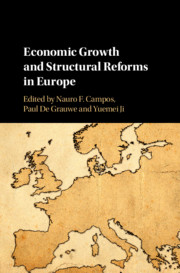Book contents
- Economic Growth and Structural Reforms in Europe
- Economic Growth and Structural Reforms in Europe
- Copyright page
- Contents
- Figures
- Tables
- Contributors
- Introduction
- Part I Economic Growth and Structural Reforms in Europe
- 1 Euro Area Growth and European Institutional Reforms
- 2 Structural Reforms and Growth
- 3 Regulation, Institutions and Economic Growth in Advanced, Emerging and Developing Countries
- Part II Macroeconomic Implications of Reforms
- Part III Case Studies
- Conclusions
- Index
- References
3 - Regulation, Institutions and Economic Growth in Advanced, Emerging and Developing Countries
from Part I - Economic Growth and Structural Reforms in Europe
Published online by Cambridge University Press: 31 March 2020
- Economic Growth and Structural Reforms in Europe
- Economic Growth and Structural Reforms in Europe
- Copyright page
- Contents
- Figures
- Tables
- Contributors
- Introduction
- Part I Economic Growth and Structural Reforms in Europe
- 1 Euro Area Growth and European Institutional Reforms
- 2 Structural Reforms and Growth
- 3 Regulation, Institutions and Economic Growth in Advanced, Emerging and Developing Countries
- Part II Macroeconomic Implications of Reforms
- Part III Case Studies
- Conclusions
- Index
- References
Summary
This chapter uses the OECD’s newly assembled Structural Policy Indicators Database for Economic Research (SPIDER) to gauge on the impact of regulation and institutions on economic growth. We investigate for a sample of around 100 countries and for a set of OECD countries the extent to which product and labour market regulations and policies influence per capita income levels. Our estimation results indicate that more business-friendly product market regulations are associated with higher per capita income levels. At the same time, it is more difficult to identify precisely estimated effects of labour market regulation and policies, perhaps with the exception of spending on ALMP, which tend to have a positive relation to per capita income. We also find that the quality of institutions influences a country’s level of development and that institutions interact with product market regulations. Finally, our results also show that labour market regulation and policies may attenuate or accentuate the impact of product market regulations on per capita income levels.
- Type
- Chapter
- Information
- Economic Growth and Structural Reforms in Europe , pp. 63 - 108Publisher: Cambridge University PressPrint publication year: 2020
References
- 1
- Cited by



